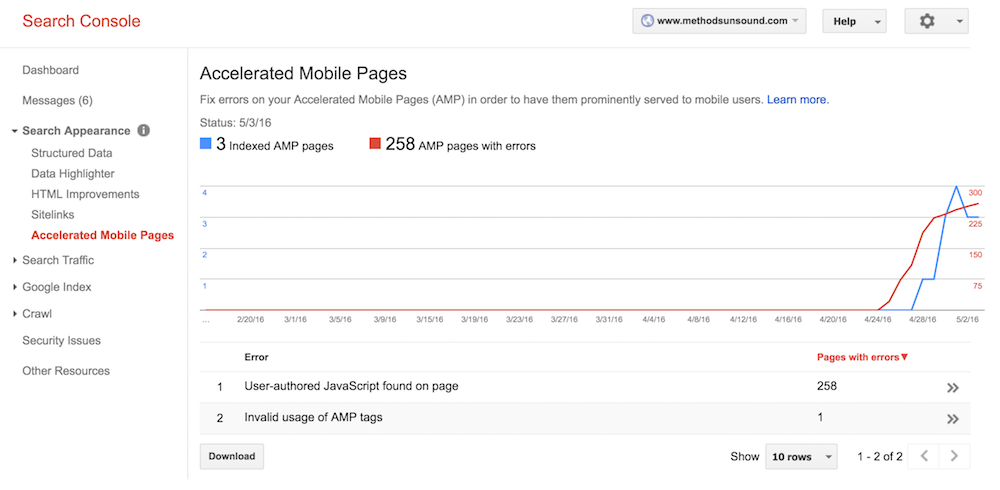So I’ve been working my backside off trying to implement Google’s Accelerated Pages, with limited amounts of success and bucket-loads of frustration and I’ve come to the point now where I have to ask… is it all really worth it?
Before we get to the wider picture of why AMP is so important, and why ultimately you probably do need to implement the thing. Let’s first answer the simple question stated in the headline…
Is Google AMP a ranking signal?
No.
Gary Illyes, Webmaster Trends Analyst at Google, stated during his SEJ Summit Chicago appearance that, “Currently, AMP is not a mobile ranking factor.”
But of course you can pull that “Currently” apart as much as you like, and read into it a high likelihood that Google will probably use it as a direct ranking factor one day soon.
As Danielle Antosz from SEJ reports, Illyes further pledged that Google will be expanding AMP vertices to include Google News, Google Now, Play Newsstand, Now On Tap, and in the near future it will likely expand to product pages for ecommerce sites like Amazon.
Which brings me to my next question…
But does it actually matter whether AMP is a ranking signal or not?
Well… (again)… No.
As you will have read countless times in countless search engine related news sites (well 3 or 4 anyway), the world of search is a drastically different place to what it was a couple of years ago and it continues to evolve every day. Every element we describe as a ‘traditional ranking signal’ is oversimplifying that element greatly.
It’s all about context, content and… stop me if you’ve heard this one before… user experience.
And that’s the key thing with AMP, it improves the user experience.
Which brings us neatly to…
Why should I implement Google AMP?
Here’s a super-quick refresher on AMP in case you’re completely lost:
Google’s Accelerated Mobile Pages are an open source initiative which aims to improve the performance of the mobile web. stripped-down versions of web pages.
When you Google search for an article on a mobile, you may have spotted the ‘lightning’ symbol. This is to indicate that by clicking on it, you will experience a cleaner, faster, streamlined version of the article that downloads instantly.

According to Kissmetrics, 40% of web users will abandon a page if it takes longer than three seconds to load, and that’s just on a desktop.
With mobile there are masses of other issues that can lead to abandonment – connection faults, poor formatting, non-mobile optimised content, badly placed links – so you can imagine why, if now more than 50% of searches take place on mobile, Google would want to improve the mobile web. It’s difficult to monetise a crappy experience.
According to Gary Illyes, AMP pages have a four times faster than average load time, 90% of publishers are seeing higher CTRs, 80% of publishers are getting more views, and the majority of publishers are seeing higher eCPMs.
So clearly AMP is working. Searchers are clicking through, they’re enjoying the experience, they’re seeking more AMP content to read… Wait. Hang on…
Of course AMP traffic is growing! For almost every content-related search I do on a mobile it’s difficult to get past the attractive, image-heavy carousel of AMP posts at the top of SERPs… of course the CTR is going to be a high! It’s basically a stacked deck.
Unfortunately if you’re (to continue the horrible analogy) in the game, you will need to sit at the table.
Implementing AMP is dead easy though right?
Uh…
Let’s just take a look at my Search Console AMP results for my own site right now. I have 258 pages with errors.

And this is after implementing all of Yoast’s recommendations and various plug-ins. Frustratingly I can see my AMP pages actually working, just by adding the /amp/ suffix to my URLs, yet I’m still seeng these errors.
But perhaps my own ultimate frustration lies in the fact there doesn’t seem to be much point in implementing AMP if my site doesn’t show up in Google News, as its the News carousel that provides all of the AMP content.
We already looked at why SEOs are so slow to implement AMP just a couple of months ago, and revealed that only 23% of SEOs are currently using AMP. It’s reasons such as the above that add to this general malaise.
There’s also the potential loss of revenue to consider…
As Rebecca Sentance reported in May, “Because AMP strips out a lot of the dynamic elements that slow down page loading time, search marketers have to do away with features that they depend on for business, such as comment systems, lead capture forms and other types of pop-up.”
Implementing AMP is obviously good for user experience, but of course Google is primarily a business…
Google launched three ad formats for AMP last month, intended to gain some ad share in mobile display advertising away from Facebook and other competitors.
AMP could be read as Google’s sly way to make you remove all your own ads in order to conform to its faster mobile web, then encouraging you to join up with it’s own ad exchange platform Doubleclick because you need to generate revenue somehow.
But then all of this could become horribly unstuck when every mobile web user on the planet decides they’ve truly had enough and downloads an ad-blocker.
Tl;dr: yeah you should probably implement AMP, Google has you right where it wants you anyway.
The article Is Google AMP a ranking signal? was first seen from https://searchenginewatch.com
No comments:
Post a Comment